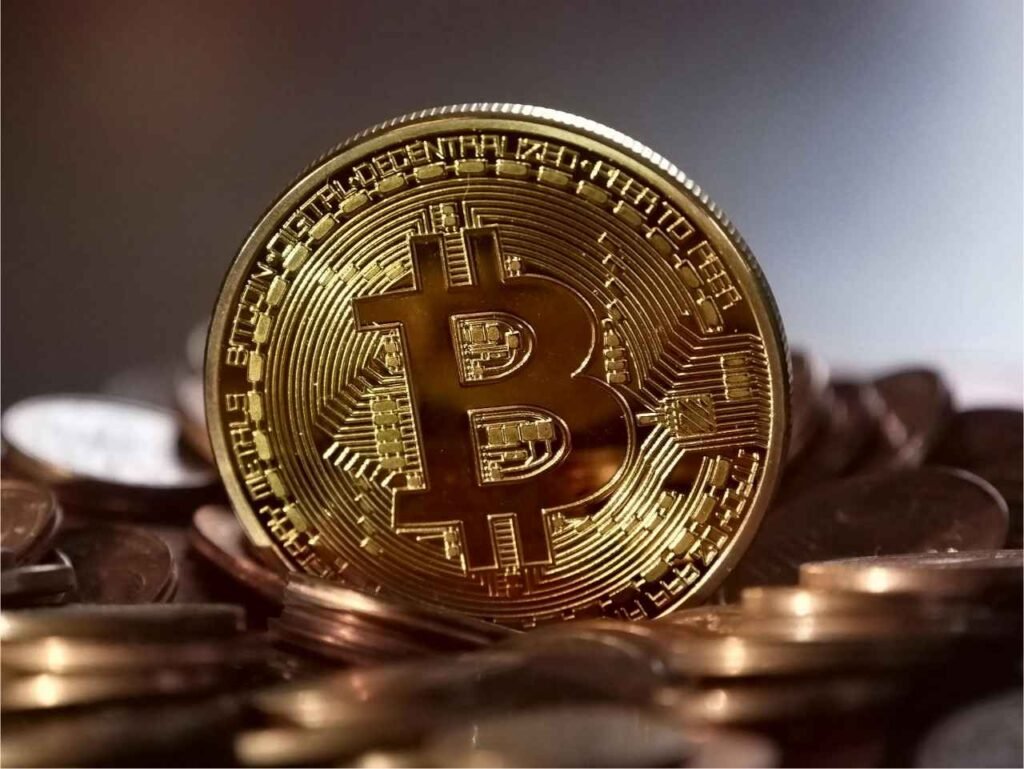
Are you curious about Bitcoin but feel overwhelmed by the technical jargon and conflicting advice? You’re not alone. When I first dipped my toes into the cryptocurrency world, I found myself drowning in complex explanations and risky recommendations.
After years of navigating this exciting but often confusing space, I’ve created this straightforward guide to help you understand Bitcoin basics, make informed decisions, and avoid common pitfalls that many beginners face.
Whether you’re looking to invest, learn about blockchain technology, or simply understand what all the buzz is about, this comprehensive guide will give you the foundation you need to move forward with confidence.
What is Bitcoin Really? Understanding the Basics
Bitcoin is the world’s first decentralized digital currency. Created in 2009 by an anonymous person (or group) using the pseudonym Satoshi Nakamoto, Bitcoin operates without a central authority like a bank or government.
But what does that actually mean for you?
Think of Bitcoin as digital money with some key differences from the dollars in your bank account:
- Limited supply: Unlike traditional currencies that can be printed endlessly, Bitcoin has a fixed maximum supply of 21 million coins. This scarcity is built into its code.
- Decentralized control: No single entity can control or manipulate Bitcoin. It’s maintained by a global network of computers.
- Transparent yet private: All Bitcoin transactions are recorded on a public ledger called the blockchain, but your personal identity can remain private.
- Borderless transfers: You can send Bitcoin to anyone anywhere in the world without requiring permission from banks or payment processors.
How Bitcoin Works: A Simple Explanation
At its core, Bitcoin works through a technology called blockchain – essentially a digital ledger that records all transactions across a network of computers.
Here’s a simplified breakdown of how it works:
- You decide to send Bitcoin to someone
- This transaction is grouped with others into a “block”
- The block is verified by thousands of computers (miners) around the world
- Once verified, the block is added to the chain of previous blocks
- The transaction is complete, and the recipient receives the Bitcoin
This process makes Bitcoin secure and resistant to fraud or manipulation. Each transaction is verified by consensus rather than by a central authority.
Why People Are Interested in Bitcoin: Beyond the Hype
Bitcoin has moved far beyond its early reputation as merely a speculative investment or tool for tech enthusiasts. Today, people are interested in Bitcoin for various practical reasons:
As a Potential Investment
Many view Bitcoin as “digital gold” – a hedge against inflation and economic uncertainty. Its limited supply means it can’t be devalued through excessive “printing” like traditional currencies.
While Bitcoin’s price has been volatile, early investors who held through the ups and downs have seen substantial returns. However, it’s important to understand that past performance doesn’t guarantee future results.
As a Technology Revolution
The blockchain technology that powers Bitcoin is revolutionizing how we think about trust, transparency, and security in digital transactions. Many believe this technology will transform industries beyond finance, including supply chain management, voting systems, and digital identity.
As Financial Freedom
For people in countries with unstable currencies or restrictive banking systems, Bitcoin offers an alternative way to store value and make transactions outside of traditional financial structures.
As a Learning Opportunity
Understanding Bitcoin means learning about economics, computer science, cryptography, and game theory – making it an intellectually rewarding journey regardless of whether you invest.
How to Buy Your First Bitcoin: A Step-by-Step Guide
Ready to acquire some Bitcoin? Here’s how to do it safely:
Step 1: Choose a Secure Exchange
To buy Bitcoin, you’ll need to use a cryptocurrency exchange – a platform that allows you to convert traditional currency (like USD) into Bitcoin.
Some reputable exchanges for beginners include:
- Coinbase: User-friendly interface with strong security features
- Gemini: Founded by the Winklevoss twins with a focus on regulatory compliance
- Kraken: Excellent security track record and reasonable fees
- Cash App: Simple option for buying smaller amounts
When choosing an exchange, prioritize:
- Security features (two-factor authentication, cold storage)
- Ease of use
- Reasonable fees
- Available in your country
- Good customer support
Step 2: Create and Verify Your Account
After selecting an exchange:
- Sign up with your email and create a strong password
- Complete identity verification (usually requiring government ID and proof of address)
- Set up two-factor authentication (2FA) for additional security
The verification process might take a few days but is essential for security and regulatory compliance.
Step 3: Connect a Payment Method
Most exchanges allow you to connect:
- Bank accounts (lowest fees but slower)
- Debit cards (faster but higher fees)
- Credit cards (immediate but highest fees)
I recommend using a bank account for larger purchases to minimize fees.
Step 4: Make Your First Purchase
Now you’re ready to buy:
- Navigate to the “Buy” section of your chosen exchange
- Select Bitcoin (BTC)
- Enter the amount you want to purchase (either in dollars or BTC)
- Review the transaction details, including fees
- Confirm your purchase
Pro tip: Consider using the “dollar-cost averaging” strategy – buying a fixed dollar amount on a regular schedule regardless of price. This approach helps reduce the impact of volatility.
Storing Your Bitcoin Safely: The Most Critical Step
Once you’ve purchased Bitcoin, storing it properly is crucial. Remember the saying in the crypto community: “Not your keys, not your coins.”
Exchange Wallets: Convenient but Risky
When you buy Bitcoin on an exchange, it’s initially stored in the exchange’s wallet. This is convenient but risky – exchanges can be hacked, and you don’t control the private keys.
Use exchange storage only for:
- Small amounts you might trade soon
- While you’re setting up more secure storage
Software Wallets: The Middle Ground
Software wallets are apps you install on your computer or smartphone. They offer a good balance between security and convenience.
Reputable options include:
- Exodus: User-friendly with support for multiple cryptocurrencies
- Electrum: Bitcoin-specific with advanced features
- Blue Wallet: Excellent mobile option
Hardware Wallets: Maximum Security
For serious Bitcoin holders, hardware wallets are the gold standard for security. These are physical devices that store your Bitcoin offline.
Leading hardware wallets include:
- Ledger Nano X: Bluetooth capability with excellent security
- Trezor Model T: Touch screen interface with solid security features
- Coldcard: Bitcoin-only with air-gap capability for maximum security
A hardware wallet typically costs $50-$150 – a small price to pay for protecting valuable assets.
Setting Up Your Wallet: The Crucial Seed Phrase
When setting up any non-exchange wallet, you’ll be given a “seed phrase” – typically 12-24 random words. This is essentially the master key to your Bitcoin.
Critical seed phrase rules:
- Write it down physically (never digitally)
- Store it in a secure location (consider a fireproof safe)
- Never share it with anyone
- Consider creating a backup stored in a second location
- Never take a photo of it or store it on your computer/phone
If you lose your seed phrase and your wallet is damaged or lost, your Bitcoin is gone forever.
Common Beginner Mistakes and How to Avoid Them
Learning from others’ mistakes can save you money and stress:
Mistake #1: Investing More Than You Can Afford to Lose
Bitcoin remains volatile despite its growth. Only invest what you can afford to lose entirely without affecting your financial well-being.
Solution: Start small, perhaps with just 1-5% of your investment portfolio, and increase gradually as your knowledge grows.
Mistake #2: Falling for Scams and “Get Rich Quick” Schemes
The cryptocurrency space is unfortunately filled with scams targeting newcomers.
Red flags to watch for:
- Promises of guaranteed returns
- Pressure to “act now”
- Requests to send Bitcoin to “verify” your wallet
- Unsolicited investment opportunities via social media or email
- “Secret” investment strategies or insider information
Remember: No legitimate Bitcoin investment offers guaranteed returns or requires you to send Bitcoin to “unlock” rewards.
Mistake #3: Trying to Time the Market
Even experienced traders struggle to predict Bitcoin’s price movements.
Solution: Consider dollar-cost averaging – investing a fixed amount regularly regardless of price – rather than trying to buy at the “perfect” time.
Mistake #4: Neglecting Security Basics
Poor security practices can lead to devastating losses.
Essential security habits:
- Use unique, strong passwords for exchange accounts
- Enable two-factor authentication everywhere
- Be wary of phishing attempts
- Keep your operating system and software updated
- Never discuss how much Bitcoin you own publicly
Mistake #5: Not Keeping Proper Tax Records
In most countries, Bitcoin transactions are taxable events. Failing to track and report them can lead to tax problems.
Solution: Use tracking software like CoinTracker, Koinly, or TaxBit to maintain records of all purchases, sales, and transfers.
Understanding Bitcoin’s Legal Status and Taxes
Bitcoin’s legal status varies by country. In the United States, Bitcoin is legal but considered property for tax purposes, meaning:
- When you sell Bitcoin for profit, you owe capital gains tax
- If you hold Bitcoin for more than a year before selling, you qualify for lower long-term capital gains rates
- Using Bitcoin to purchase goods or services is also a taxable event
- Mining Bitcoin or receiving it as payment is considered income
I strongly recommend consulting with a tax professional familiar with cryptocurrencies to ensure compliance with your local laws.
Growing Your Bitcoin Knowledge: Next Steps
As you become more comfortable with Bitcoin basics, consider expanding your knowledge:
Technical Understanding
- Learn about Bitcoin’s underlying technology and protocol
- Understand concepts like nodes, mining, and the halving cycle
- Explore the differences between Bitcoin and other cryptocurrencies
Economic Considerations
- Study Bitcoin’s potential role in the broader financial system
- Learn about monetary policy and how it relates to Bitcoin
- Understand market cycles and volatility patterns
Security Expertise
- Master advanced security practices
- Learn about multi-signature setups for enhanced protection
- Understand inheritance planning for digital assets
Final Thoughts: Your Bitcoin Journey
Bitcoin represents not just a new form of money but a paradigm shift in how we think about value, trust, and financial sovereignty. While the learning curve may seem steep at first, taking it step by step will help you build confidence and knowledge.
Remember that everyone in the Bitcoin space was a beginner once. The most important qualities for success are patience, curiosity, and a commitment to security best practices.
Have questions about getting started with Bitcoin? Drop them in the comments below, and I’ll personally respond to help you on your journey!
Disclaimer: This article is for informational purposes only and should not be considered financial advice. Cryptocurrency investments involve significant risk. Always do your own research and consider consulting with a financial advisor before making investment decisions.



